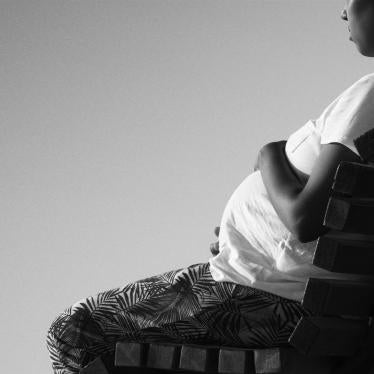Chicago’s 1995 heat wave, which peaked in mid-July, killed 739 people, including disproportionately high numbers of Black, older, and socially isolated people. From catastrophe sprang then-novel city government policies designed to never allow a heat emergency — and, historians said, poor planning — to kill like that again.
Twenty-five years later Chicago still uses public communication strategies to urge residents to pay attention to excessive heat warnings, now more frequent because of climate change. Ahead of and during heat waves, the media relay official recommendations on staying cool and checking in on friends and relatives, especially those at risk because of health problems like heart conditions. The city even provides a full webpage of advice on “Pet Summer Safety Tips for Extreme Heat.”
But Chicago does not include advice about how heat affects pregnancy in official advisories, and city officials confirmed to Human Rights Watch that there is no public information outreach for pregnant people in the Chicago heat. Pregnancy is also not mentioned in the city’s climate change planning documents, and officials working on heat do not typically consult groups that work to ensure equal access to the best care during pregnancy.
Heat is merely an inconvenience to many, but dangerous heat is likely to disproportionately affect some pregnant people more than others, exacerbating existing racial and ethnic disparities in who gets to have a healthy baby.
This omission is a public health issue. A growing body of evidence indicates that exposure to heat is linked to preterm birth, low birth weight, and other harm. Premature births and low birth weight make it more likely a baby will die in their first year and are linked to both immediate health problems and some that can last a lifetime. Pregnant people are also at greater risk of heat stress, a serious concern for those who work in hot warehouses and kitchens or outdoors — often marginalized, underpaid work.
Our global climate crisis means that Chicago may have heat waves like 1995′s three times a year by the end of the century if global carbon emissions continue to rise. Such extremes may be avoidable with drastic emission cuts. But because of past emissions we can expect dangerous, grindingly hotter summers regardless.
The preterm birth rate for white people in Chicago is 7.9 percent (well below the U.S. average of about 10 percent), but for Black people it is 14.2 percent. The difference in low birth weight is even more dramatic, 6.3 percent for white parents and 14.7 percent for Black parents. In 2017, 127 Black babies in Chicago died before their first birthday, compared with 39 white babies — in a city about 30 percent Black and 50 percent white.
Exposure to heat threatens to exacerbate these disparities further, according to one expert, Dr. Rupa Basu, head of the air and climate epidemiological section for the Office of Environmental Health Hazard Assessment in California. Majority-Black communities in Chicago are lower income and less likely to be able to run expensive air conditioning. A nationwide study found that most formerly redlined areas, still mostly home to people of color, including in Chicago, were hotter than whiter neighborhoods, because of less green space and trees and more concrete and roads.
Chicago’s highest number of 1995 heat deaths occurred in marginalized and poorer areas, often Black neighborhoods, where many did not have air conditioning and where crime meant that some were unwilling to open their windows. Twenty-five years later, persistent inequities in health, wealth, access to housing, and other indicators are translating into disproportionate illness and deaths from COVID-19 in communities of color.
COVID-19 is going to make heat more dangerous this year. In past summers, families could go to the mall, a park or to visit a relative with air conditioning to cool off if they did not have it or could not afford to use it. Social distancing makes all of these difficult and will make Chicago’s six cooling centers harder to use safely, even if they follow the Centers for Disease Control and Prevention’s advice, which would reduce the number of people using the centers.
This issue goes beyond Chicago, of course. All US cities need to address heat and other issues through the lens of the bigger picture of racial, ethnic, and reproductive justice. They all need to think about healthy pregnancies and babies, and disparate impacts on Black and brown people, when they plant trees or invest in other cooling efforts. Heat health information needs to include pregnancy, and climate change planning should involve reproductive health workers and activists.
The disproportionate impact of COVID-19 on communities of color in Chicago lays bare the many ways in which the government has failed to address the underlying inequities that drove many of the deaths in 1995. Chicago officials should be motivated by lessons from the past as well as the hotter future it shares with the world, to rethink how to address heat emergencies in ways that simultaneously address structural racism.










